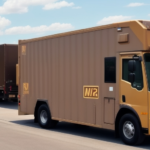Are Shipping Rates the Same for UPS Stores and Small Business Accounts?
Shipping costs represent a significant expense for small businesses, making it crucial to understand how rates are calculated and whether there are differences between UPS Stores and small business accounts. In this comprehensive guide, we delve into everything you need to know about UPS shipping rates for small businesses, incorporating the latest data and authoritative sources to ensure accuracy.
Understanding the Difference Between Shipping Rates for UPS Stores and Small Business Accounts
UPS offers distinct shipping rates for UPS Stores and small business accounts. UPS Stores are retail locations providing a variety of shipping and printing services, typically at higher rates compared to small business accounts. Small businesses shipping at least 10 packages per week can qualify for discounted rates, leading to substantial savings over time. According to UPS's official rate guide, these discounts are based on shipping volume, package weight, and destination.
The Impact of Volume on Shipping Costs for Small Businesses
Volume is a critical factor in determining shipping costs for small businesses. The more packages you ship, the lower your cost per package becomes. Negotiating with UPS based on your shipping volume can lead to better rates and service options. UPS offers incentives for high-volume shippers, including tiered pricing and enhanced support.
However, shipping volume isn't the only determinant. Package weight, size, and the distance they travel also influence shipping costs. It's essential to consider these factors when negotiating rates with UPS or other shipping providers. According to the 2023 UPS Shipping Trends Report, businesses that optimize these variables can achieve up to a 15% reduction in shipping costs.
Alternative shipping methods, such as using regional carriers or consolidating shipments, can further reduce costs. Regional carriers may offer lower rates for local shipments, while consolidation reduces the overall number of packages, leading to cost savings.
How to Negotiate Better Shipping Rates with UPS for Your Small Business
Negotiating better shipping rates with UPS involves demonstrating consistent shipping volume and leveraging your business's reliability. Providing UPS with detailed shipping data can help secure favorable rates. Additionally, comparing rates with other carriers ensures you're getting the best deal.
Utilizing UPS's prepaid shipping options, where you pay for shipments upfront, can result in lower rates and improved service options. Negotiating fee waivers, such as residential delivery fees or fuel surcharges, by committing to a minimum shipping volume or a long-term contract can also yield significant savings.
Choosing the appropriate UPS service based on your business needs can further optimize costs. For instance, businesses frequently shipping large or heavy items might find better rates with UPS Freight’s LTL services.
Comparing UPS Rates to Other Major Carriers for Small Businesses
To ensure you're receiving the best rates, it's vital to compare UPS's shipping rates with those of other major carriers like FedEx, USPS, and DHL. Each carrier offers unique advantages:
- FedEx: Known for same-day and next-day delivery options, ideal for time-sensitive shipments.
- USPS: Offers flat-rate boxes and envelopes, which can be cost-effective for certain package sizes.
- DHL: Specializes in international shipping, providing competitive rates for overseas deliveries.
By evaluating additional services and rates, you can determine which carrier best aligns with your business needs. According to the Carrier Comparison Report 2023, businesses that regularly compare carriers save an average of 10% on shipping costs.
Understanding How UPS Calculates Shipping Costs
UPS calculates shipping costs based on several factors:
- Package Weight and Dimensions: Heavier and larger packages incur higher shipping fees.
- Shipping Speed: Faster delivery options, such as overnight shipping, are more expensive.
- Destination Address: Longer distances and international shipments increase costs.
Additionally, UPS offers various services like freight, international shipping, and specialized packaging, which can affect overall costs. Properly classifying items, especially hazardous or oversized materials, is essential to avoid unexpected fees.
Tips for Reducing Shipping Costs Without Compromising on Quality
Managing shipping costs effectively requires strategic planning:
- Optimize Packaging: Use smaller boxes or envelopes and lightweight cushioning materials to reduce package weight and dimensions.
- Consolidate Shipments: Combine multiple orders into a single shipment to save on shipping fees and reduce the number of packages.
- Choose the Right Shipping Method: Opt for ground shipping for non-urgent orders to benefit from lower rates.
- Negotiate Rates: Regularly review and renegotiate shipping rates based on current shipping volumes and business growth.
Implementing these strategies can lead to significant cost savings. For example, businesses that switched to optimized packaging saw a 12% reduction in shipping costs, as reported by the 2023 Shipping Optimization Report.
Factors That Affect Shipping Rates for UPS Stores and Small Business Accounts
Several factors influence UPS shipping rates for both UPS Stores and small business accounts:
- Package Weight and Dimensions: Larger and heavier packages cost more to ship.
- Shipping Speed: Expedited shipping options are pricier than standard shipping.
- Destination Address: Shipping to remote or international locations increases costs.
- Service Type: Choosing between ground, air, or freight services affects the overall rate.
- Seasonal Demand: Rates may increase during peak seasons like holidays due to higher demand and limited capacity.
Understanding these factors helps businesses make informed decisions about their shipping strategies, ensuring cost-effectiveness and timely deliveries.
How to Optimize Your Packaging to Save on Shipping Costs
Efficient packaging is key to reducing shipping costs without compromising product safety:
- Use Appropriate Sized Packaging: Select the smallest possible box or envelope that safely holds your product to minimize weight and dimension-based costs.
- Consolidate Items: Combine multiple products into a single package when feasible to reduce the number of shipments.
- Lightweight Materials: Utilize lightweight cushioning materials to protect items without adding excessive weight.
Additionally, choosing the right shipping method based on your packaging can further optimize costs. For domestic shipments, ground shipping is often more economical than air shipping. For international shipments, using a consolidator service can lower costs by bundling multiple shipments into one larger delivery.
Understanding the Different Types of UPS Services Available for Small Businesses
UPS provides a range of services tailored to small business needs:
- UPS Ground: Cost-effective for non-urgent shipments within the U.S.
- UPS Air: Includes expedited services like UPS Next Day Air for faster deliveries.
- UPS Freight: Suitable for large, heavy, or bulky items that require less-than-truckload (LTL) shipping.
- International Shipping: Comprehensive solutions for shipping abroad, including customs clearance and international tracking.
- Specialized Packaging: Options like temperature-controlled packaging for perishable items ensure product integrity during transit.
Choosing the right service depends on factors such as shipping volume, package size, destination, and required delivery speed.
How to Choose the Right UPS Service Based on Your Business Needs and Budget
Selecting the appropriate UPS service involves evaluating several key factors:
- Shipping Volume: Higher volumes may qualify for discounts or specialized services like UPS Freight.
- Package Weight and Dimensions: Heavier and larger packages might be more cost-effective with ground or freight services.
- Destination Address: Domestic vs. international shipping considerations.
- Delivery Speed: Balancing cost with the necessity for expedited delivery.
- Additional Services: Package tracking, insurance, and customer support options.
Considering these factors ensures that you select a UPS service that aligns with your budget and meets your business requirements effectively.
The Benefits of Using a Third-Party Logistics Provider to Manage Your Shipping Needs
Outsourcing shipping to a third-party logistics (3PL) provider can offer numerous advantages for small businesses:
- Cost Savings: 3PLs often have negotiated rates with carriers, providing lower shipping costs than individual businesses can achieve.
- Efficiency: Streamlined order fulfillment and shipping processes enhance delivery speed and reliability.
- Scalability: Easily adjust shipping strategies based on business growth without the need for significant infrastructure investments.
- Expertise: Access to industry knowledge and advanced shipping technologies to optimize logistics.
By partnering with a 3PL provider, small businesses can focus on core operations while ensuring their shipping needs are handled efficiently and cost-effectively.
Frequently Asked Questions About UPS Shipping Rates for Small Businesses
Here are some frequently asked questions about UPS shipping rates for small businesses:
- What is the average cost of shipping with UPS for small businesses?
- How can I qualify for discounted shipping rates with UPS?
- What factors impact UPS shipping rates for small businesses?
- How do UPS rates compare to other major carriers?
- Do I need to purchase insurance for my packages?
- What are the different types of UPS shipping services available for small businesses?
- How can I optimize my packaging to save on shipping costs?
By addressing these questions, small businesses can make informed decisions about their shipping strategies, ensuring they receive the best possible rates and services from UPS.
In conclusion, shipping rates for UPS Stores and small business accounts can vary significantly. It's essential for small business owners to understand the factors influencing these rates and implement strategies to optimize shipping costs. By leveraging volume discounts, negotiating effectively, optimizing packaging, and considering alternative shipping methods or 3PL providers, businesses can reduce shipping expenses, enhance delivery efficiency, and focus on scaling their operations.






















